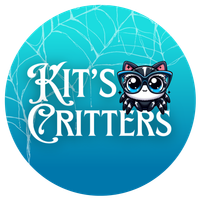Jumping Spider Care Guide
General care guide for most common jumping spiders like P. regius.
If in doubt, ask your breeder!
Housing
Jumping spiders are arboreal, meaning they will most likely spend most of their time at the top of their enclosure. Providing an enclosure that opens on the bottom or side/front is necessary to avoid breaking delicate web hammocks and disrupting the spider. Ventilation holes or mesh on at least two opposite sides is necessary to provide air circulation and prevent mold growth. For juveniles, a 4x4x4 enclosure is adequate, moving them up to a 4x4x8 (approximately) when they reach sub-adulthood.

Feeding and Water
Feed your spider based on abdomen size. See the chart! For juveniles this could be as often as 1-2 times a week, while adults may only eat every few weeks. Here are my preferred feeder insects based on age:
i5-i6: Hydei Flightless Fruit Flies, SMALL mini mealworms (cut into small pieces if your spider seems intimidated by the mealworm, and/or crush the head to prevent it from biting back).
i7 to Adult: Mini mealworms, bluebottle spikes, bluebottle flies, small crickets.
Some feeders like mealworms and crickets have the potential to injure your spider. Crushing the head slightly will prevent them from biting. Never leave uneaten crickets or mealworms in an enclosure unattended.
Note: Jumping spiders eat by turning the insides of the prey into digestible goo and sucking it out. When they’re finished, they leave behind the empty husk of the feeder insect. It can take several hours for your spider to finish its meal.
For water, mist an undecorated side of the enclosure once a day, preferably with distilled water. Mist twice a day while the spider is in molt/pre-molt, or if you live in a very dry climate.
Lighting
Bright light is necessary for your spider’s happiness and to help them hunt. A cool toned white LED lamp is ideal, as it provides bright light without creating extra heat. They require 12 hours of “daytime” light, followed by 12 hours of darkness. Do not keep your spider in direct sunlight, as this can overheat their enclosure very quickly.
Heat and Humidity
Unless otherwise directed by your breeder, your jumping spider will thrive between 72- and 78-degrees Fahrenheit. Humidity of 50% to 70% is also sufficient, or higher when molting. Some species of jumping spider require higher or lower humidity or temperature. Please check with your breeder for accurate care information.
Handling
Handling your spood should be enjoyable for both of you, but it is never something you HAVE to do. If you do not wish to hold your spider, and they have enough enrichment in their enclosure, you never have to hold them if you don’t want to! If you decide you do want to handle your spider, the most important thing is patience.
Make sure your hands are clean and dry, and free from lotions or oils. Choose an area like a table, desk, or bed, to minimize the risk of the spider getting lost if they decide to make a break for it. Having a “catch cup” on hand, like the one your spider was shipped in, will let you catch them safely if needed.
Offer your hand or finger to your spider and allow them to come to you. They might walk right on, they might run away, or they might tap you with a leg a couple of times before deciding. Allowing them to come out of their enclosure before offering your hand might encourage their curiosity. The more exposure they have to the feel of your skin, the more comfortable they will be, but give it time and don’t rush things.
Be mindful of their “dragline” – the thin thread of web they drop behind them while exploring. While your spider is walking from one hand to the other, bring your empty hand under the one holding the spider, so you avoid pulling the dragline upwards with the spider attached!
It is also important to note that not all spiders will want to be handled, and some will take longer than others to get used to you. Every spider is different!
Molting
Jumping spiders can molt eight to twelve times or more in their lifetime. Once they reach maturity, they do not molt again. Molting is incredibly hard on a tiny spider, can take a few hours to several days to complete, and the process repeats every 1 to 2 months until maturity. During pre-molt they will make a thick hammock, and they will disappear into the hammock until they have finished shedding their exoskeleton. It is extremely important to never interfere with a spider if they are inside their hammock. Doing so can cause difficulties with the molting process and even result in death.
Once they have molted, make sure to wait 2-3 days for their exoskeleton to harden before offering food. During the entire process, misting the enclosure twice a day is recommended, as the increased humidity will help them have a healthy molt.
Household Dangers
Jumping spiders are sensitive to strong scents and chemicals. Avoid using incense, scented candles, perfumes, etc.
Topical flea and tick treatments used on cats and dogs can also cause issues for jumping spiders. If you use them, keep your four-legged babies away from your eight-legged ones, and wash your hands thoroughly before handling your spider. If possible, ask your vet about switching to edible flea and tick prevention, for maximum safety.
Be mindful if using pesticides and insecticides anywhere outside your house. Keep windows, vents and doors closed until it is safe to open them again.
